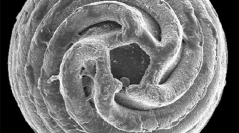

 Cryptogamie, Algologie
25 (2) - Pages 175-188
Cryptogamie, Algologie
25 (2) - Pages 175-188In order to reconstruct Holocene climatic changes in Sidi Bou Rhaba, sediment records of the Charophyte populations dynamics were examined. A 120 cm long core was collected from the southern zone of the lake and analysed for charophyte remains. Sediment samples revealed the presence of thousands of oospores. However, all spores were empty and devoid of starch, showing that they had lost their ability to germinate.The determinable fossil and viable subfossil remains consisted of calcified gyrogonites. These were attributed to four Charophyte taxa: Lamprothamnium papulosum (Wallroth) J. Groves, Chara aspera Detharding exWilldenow, C. connivens Salzmann ex A. Braun and C. baltica Bruzelius. The palaeoecological significance of these species is relevant to inferring past environmental conditions for Sidi Bou Rhaba. Two of the species, L. papulosum and C. baltica, have never been recorded living in this site. They are typically indicative for a brackish water habitat. Their past presence was likely a response to higher water salinity than present and can be interpreted as corresponding to a series of dry years. On the contrary, C. connivens marked a period of dilution, indicating more humid years. Chara aspera is oligohaline, and can tolerate a range of salinity from freshwater to up to 12 g·l–1, whereas C. baltica is adapted to more brackish water up to a salinity of ca 15 g·l–1. The quantitative changes in the abundances of the remains of these taxa throughout the sediment core indicate that the salinity of Sidi Bou Rhaba has fluctuated during the past century.